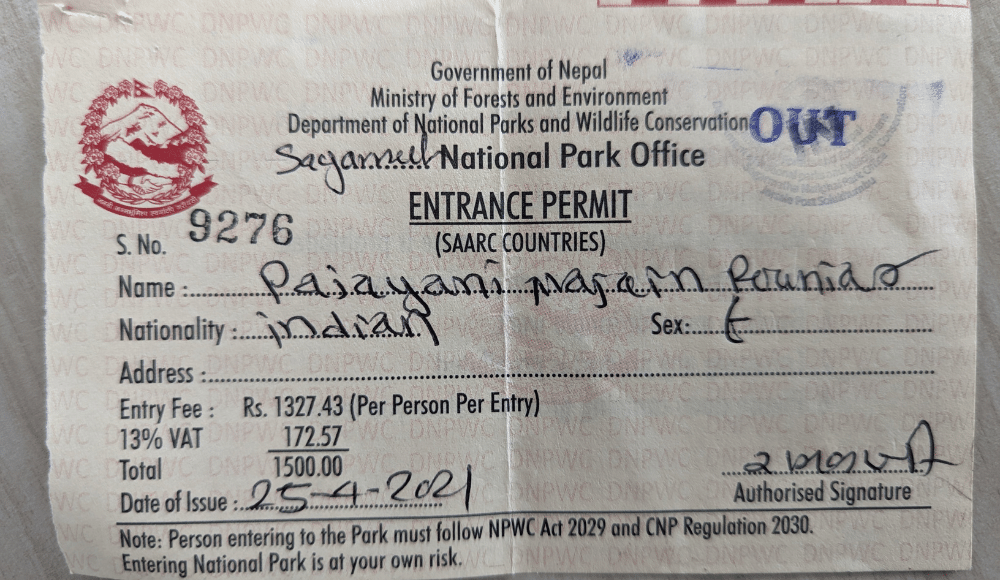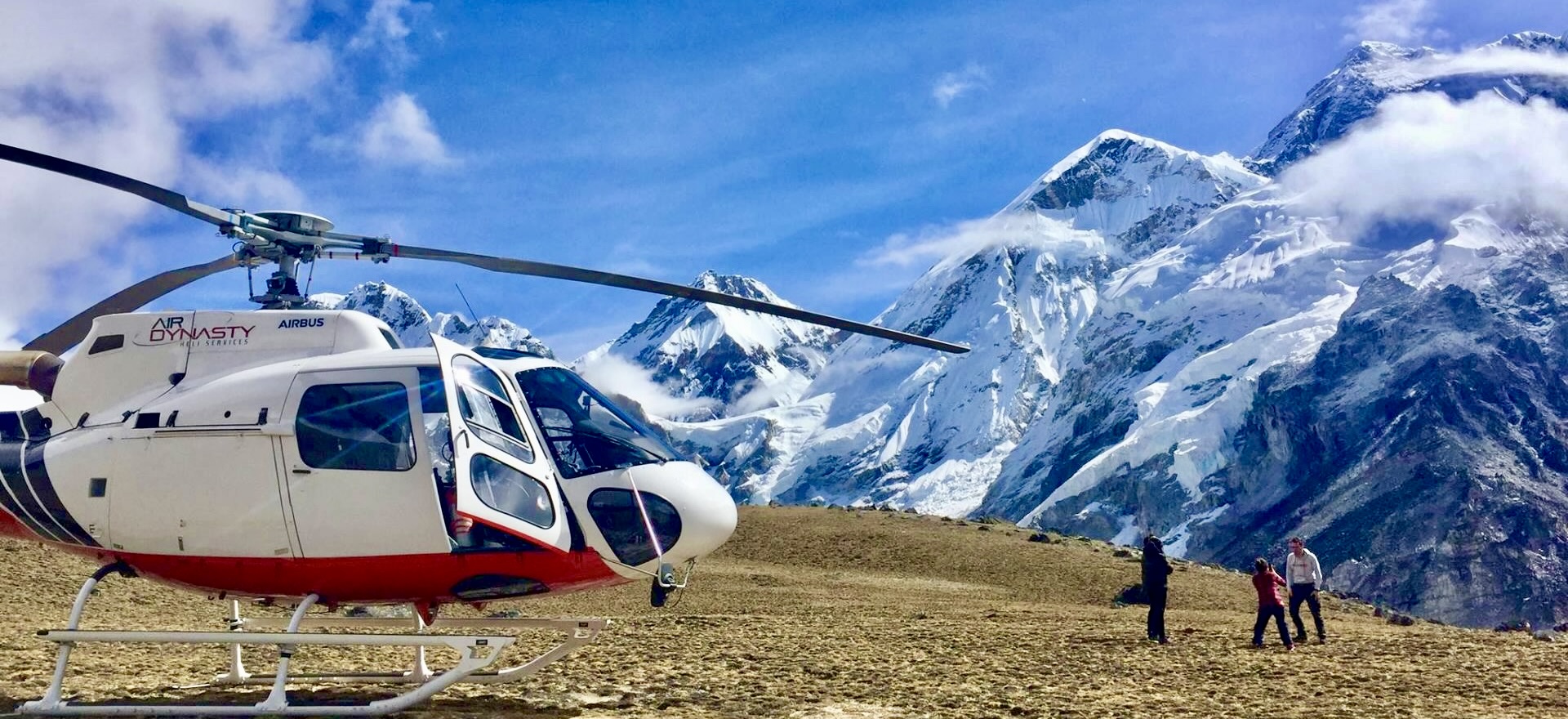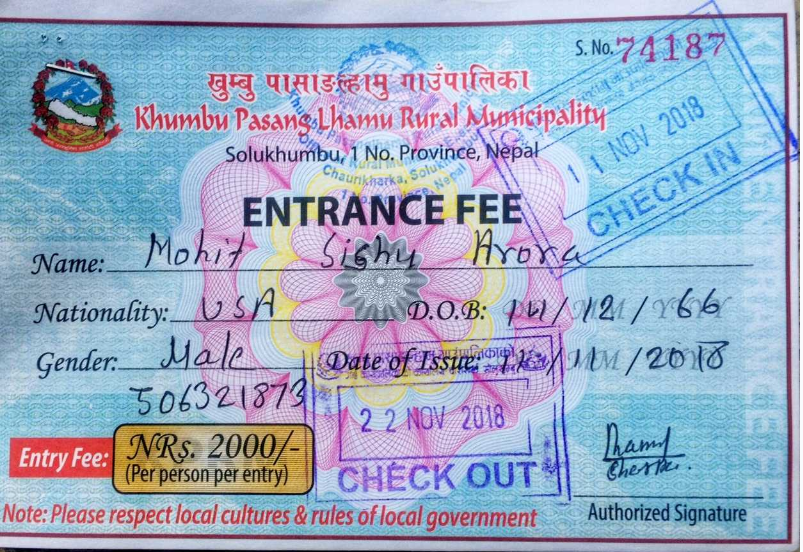- Introduction
- The Magnificent Everest Region
- The Ultimate Itinerary
- Things to keep in mind while doing Everest Base Camp Helicopter Tour
- Permits for Everest Base Camp Helicopter tour
- What to Expect During the Everest Base Camp Helicopter Tour
- Packing Essentials for Everest Base Camp Helicopter Tour
- Health and Safety Tips
- Environmental Responsibility
- Personal Experiences and Testimonials of our Beloved client
- What is the duration of an Everest Base Camp helicopter tour?
- Are there any weight restrictions for passengers on a helicopter tour?
- What is the best time of year to take a helicopter tour to Everest Base Camp?
- What are the main highlights and landmarks visible during the helicopter tour?
- Are there any health considerations or altitude-related issues to be aware of before taking a helicopter tour to Everest Base Camp?
- What is the maximum altitude reached during the helicopter tour?
Introduction
Everest. The name itself conjures images of snow-capped peaks, daring expeditions, and the pinnacle of human achievement. For many, scaling its heights remains a dream, locked away by time, fitness, or budget. But what if we told you there's another way to experience the awe-inspiring majesty of Everest: by helicopter?
Everest Base Camp is undeniable—a place where adventurers embark on their quest to conquer the world's highest peak. But did you know that there is an alternative way to experience the thrill of this iconic destination? In this blog post, we will delve into the realm of Everest base camp helicopter tours, an exciting and convenient way to explore Everest Base Camp. Contact us as we preview the benefits, experiences, and, of course, the permits required for this breathtaking journey.
The Magnificent Everest Region
Before we dive into the logistics of a helicopter tour, let's first familiarize ourselves with the awe-inspiring Everest region. Nestled in the majestic Himalayas, this area boasts a remarkable geography and rich cultural heritage. From towering snow-capped peaks to picturesque valleys, the Everest region is a trekker's paradise.
.jpg)
Magnificent View of Everest
As you soar through the sky on your helicopter tour, you'll be treated to unparalleled views of key attractions and landmarks. Marvel at the iconic Khumbu Glacier, witness the beauty of Namche Bazaar, and catch a glimpse of the legendary Sherpa villages. Every turn reveals a new facet of this region.
It is impossible to discuss Everest Base Camp without acknowledging its monumental mountaineering history. As the starting point for most climbers attempting to conquer Mount Everest, the base camp holds immense significance. By embarking on an EBC helicopter tour, you are embarking on a journey molded by the footsteps and triumphs of mountain legends.
The Ultimate Itinerary
Now that we have set the stage, let's drive into the thrilling itinerary of an Everest Base Camp helicopter tour. From the moment you lift off, each day will be filled with excitement and wonder.
Sure, here is a complete, brief itinerary for a 5-hour Everest Base Camp Helicopter Tour with landing:
Morning Itinerary Plan
7:00 AM: Pick up from your hotel in Kathmandu by private vehicle and transfer to Kathmandu Airport's domestic terminal.
7:30 AM: Check-in for your Everest Base Camp Helicopter Tour.
8:00 AM: Board your helicopter and depart for Everest Base Camp. Enjoy breathtaking views of the Himalayas, including the Rolwaling Himal, the Khumbu Icefall, and Mount Everest itself.
8:30 AM: Land at Lukla Airport, the gateway to the Everest region.
8:45 AM: Take a short break at Lukla Airport to acclimatize to the high altitude (3,860 meters).
9:00 AM: Take off from Lukla Airport and fly over the Khumbu Valley, enjoying stunning views of the surrounding peaks, including Lhotse, Makalu, and Cho Oyu.
9:15 AM: Land at Everest Base Camp (5,364 meters).
9:30 AM: Spend approximately 30 minutes exploring Everest Base Camp, taking photos, and soaking in the views of Mount Everest.
10:00 AM: Take off from Everest Base Camp and fly over Kala Patthar (5,643 meters), a viewpoint offering even more spectacular views of Everest.
10:15 AM: Land at Hotel Everest View (3,880 meters), the highest hotel in the world.
10:30 AM: Enjoy a delicious breakfast at the hotel, with panoramic views of the Himalayas.
Afternoon Itinerary Plan
11:00 AM: Take off from Hotel Everest View and fly back to Kathmandu.
11:30 AM: Land at Kathmandu Airport and be transferred back to your hotel.
Things to keep in mind while doing Everest Base Camp Helicopter Tour
- The itinerary may vary depending on weather conditions and other factors.
- It is important to be in good physical health for this tour, as the high altitude can be challenging.
- Be sure to dress warmly, as the temperature at Everest Base Camp can be below freezing.
- It is also recommended to bring sunscreen, sunglasses, and a hat.
We hope this itinerary helps you plan your dream Everest Base Camp helicopter tour!
Permits for Everest Base Camp Helicopter tour
When planning a helicopter tour to Everest Base Camp in Nepal, it's essential to obtain the necessary permits to ensure a smooth and compliant journey. The two primary permits required for this helicopter trip to Everest are the Sagarmatha National Park Entry Permit and the Khumbu Rural Municipality Permit.
Sagarmatha National Park Entry Permit
This permit is a legal requirement for entering the Sagarmatha National Park, where Everest Base Camp is located. The Sagarmatha National Park permit is the key to entering Sagarmatha National Park. A Sagarmatha National Park permit can be obtained at tourist service centers in Pardasanimarg, Bhirkutimandap Kathmandu. There is a secondary option for obtaining Sagarmatha National Park permits. At the entry point of the Everest Base Camp Trek route (Monju Post), you can obtain the card easily.

Requirements for Obtaining Sagarmatha National Park Permits as Per Their Nationality!!
- For Foreign travelers, the sagarmatha national park permits cost you about NRs. 3,000 (approximately 25 USD) per person, including vat
- For Nepali people, the sagarmatha national park permits cost you about NRs. 100 (approximately 1 USD) per person, including vat
- For Trekking Guide, the sagarmatha national park permits cost you about NRs. 1,500 (approximately 13 USD) per person, including vat
- For SAARC Nationality, the sagarmatha national park permits cost you about NRs. 1,500 (approximately 13 USD) per person, including vat
Khumbu Rural Municipality Permit
In addition to the national park permit, a Khumbu Rural Municipality Permit is also necessary for visiting Everest Base Camp. Khmubu rural municipality raises some fees in terms of preserving and promoting the locality of Everest Region. The Khumbu Rural Municipality permits can be obtained through the Sagarmatha National Park counter in Monjo, or you can get permits in Lukla. There is no alternative for obtaining Khumbu Rural municipality in kathmandu.
Requirement for Obtaining Khumbu Rural Municipality Permit as Per Their Nationality!!
- For Foreign travelers, the Khumbu Rural Municipality permit cost you about NRs. 2,000 (approximately 25 USD) per person, including vat
- For SAARC Nationality, the Khumbu Rural Municipality permit cost you about NRs. 2,000 (approximately 25 USD) per person, including vat
What to Expect During the Everest Base Camp Helicopter Tour
Embarking on an Everest helicopter tour promises an unforgettable experience, filled with extraordinary views, unparalleled photo opportunities, and a unique insight into the world of aviation.

As you hover above the rugged terrain, feast your eyes on the vast expanse of snow-capped peaks. The panoramic view from the helicopter provides a perspective that words simply cannot do justice to. Capture these priceless moments with your camera and create memories that will last a lifetime.
While you marvel at the beauty below, allow yourself to appreciate the pilot's important role in ensuring your safety and enjoyment. From navigating challenging terrain to communicating vital information, the pilot's expertise and professionalism are crucial to the success of your helicopter tour.
Explore the Best Time for EBC Heli Tour!
Packing Essentials for Everest Base Camp Helicopter Tour
Preparing for your Everest Base Camp helicopter tour requires careful consideration of your clothing, gear, important documents, permits, and sustenance for the journey.
Clothing and Gear

Layering is key in the ever-changing climate of the Everest region. Pack a mix of warm and lightweight clothing, including thermal layers, a waterproof jacket, hiking boots, gloves, and a hat. Don't forget a good pair of sunglasses to shield your eyes from the intense mountain sun.
Important Documents and Permits
Ensure you have your passport, travel insurance, and all the necessary permits required for the helicopter tour. These permits include the Sagarmatha National Park entry permit and Khumbu Rural Municipality Permits.
Snacks and Hydration
The high altitude can be physically demanding, so be sure to pack enough snacks and hydration to keep you energized throughout the journey. Nuts, energy bars, and water bottles are essential companions on your helicopter tour.
Health and Safety Tips
Altitude sickness is a genuine concern when venturing into high-altitude regions. To ensure a safe and enjoyable journey, it is crucial to take the necessary precautions and be aware of emergency protocols.
Altitude Sickness Precautions
Acclimatization is key! Take your time and allow your body to adjust to the thin air as you ascend. Stay hydrated, avoid alcohol, and listen to your body's signals. If symptoms of altitude sickness persist or worsen, seek medical attention immediately.
Emergency Protocols and Communication
Familiarize yourself with emergency protocols and communication channels available during the tour. Your guide and pilot will provide you with the necessary information, ensuring your safety at all times.
General Health Tips for High-Altitude Travel
- Taking care of your health in high-altitude regions goes beyond acclimatization. Maintain a balanced diet, get enough rest, and protect yourself from the intense sunlight. Use sunscreen, stay hydrated, and listen to your body's needs.
Environmental Responsibility
As we embark on adventures in the fragile ecosystem of the Everest region, it is vital to approach our travels with environmental responsibility and respect for local communities.

Leave-No-Trace Principles During the Tour
Follow the "Leave No Trace" principles to minimize your impact on the environment. Pack out all your waste, respect wildlife and vegetation, and stay on designated trails. Let's strive to preserve the pristine beauty of this remarkable region.
Responsible Tourism Practices in the Everest Region
Support the local economy by choosing reputable tour operators that prioritize sustainable tourism practices. By understanding and respecting local cultures, customs, and traditions, we can foster a positive relationship with the communities we encounter.
Supporting Local Communities and Conservation Efforts
Consider contributing to local conservation efforts or community initiatives that aim to preserve the Everest region's natural and cultural heritage. Your support can make a real difference in protecting this fragile ecosystem for future generations.
Personal Experiences and Testimonials of our Beloved client
Through personal experiences and testimonials, we are granted a glimpse into the transformative power of an Everest Base Camp helicopter tour.
"As we soared above the breathtaking landscape, my heart skipped a beat. It was a surreal experience, unlike anything I had ever imagined. The helicopter tour allowed me to witness the grandeur of Everest Base Camp from an entirely new perspective." Lauren, avid adventurer
"The helicopter tour was the perfect option for me, as I had limited time but still wanted to experience Everest Base Camp. Every second spent in the air was a moment of pure exhilaration, and I was able to accomplish what seemed like an impossible dream." Mark, enthusiastic traveler
These personal accounts underscore the diverse perspectives and lessons learned by fellow travelers. Each story adds a touch of authenticity, highlighting the uniqueness and transformative nature of an Everest Base Camp helicopter tour.
What is the duration of an Everest Base Camp helicopter tour?
Everest Base Camp helicopter tours typically last around 4-5 hours, depending on the specific itinerary and weather conditions. This includes flight time from Kathmandu to Lukla (around 45 minutes), landing and refueling at Lukla (15–20 minutes), flight to Everest Base Camp or Kala Patthar (30–40 minutes), landing and exploration time (10–30 minutes), flight to Hotel Everest View for breakfast (15–20 minutes), landing and breakfast time (50–60 minutes), and return flight to Kathmandu (45 minutes).
Are there any weight restrictions for passengers on a helicopter tour?
Weight restrictions play a crucial role in the safety and success of helicopter tours. Each aircraft has a maximum weight limit, including passengers, luggage, and fuel. Exceeding this can compromise both safety and maneuverability, especially at high altitudes where reduced air density affects performance. Typical individual passenger weight limits range from 110 to 130 kg, and total passenger weight falls within 500 to 600 kg, depending on the helicopter model. Be sure to provide your information for specific restrictions; exceeding them could mean sitting out or paying extra for an additional seat. Be mindful of luggage limitations too, and remember, these restrictions are in place for everyone's safety.
What is the best time of year to take a helicopter tour to Everest Base Camp?
Choosing the best time boils down to your priorities. Crave clear skies and vibrant landscapes? Spring (March–May) or autumn (September–November) offer ideal weather and stunning scenery, but expect crowds and peak pricing. Prefer a quieter, potentially cheaper experience? Winter (December–February) boasts clear skies amidst the cold, but availability might be limited, and altitude sickness risk increases. Remember, monsoon season (June–August) brings limited visibility due to rain. Ultimately, the perfect timing depends on you. Prioritize ideal weather and vibrant scenery. Choose spring or autumn. Seek fewer crowds and potential cost savings. Winter could be your answer, but plan accordingly.
What are the main highlights and landmarks visible during the helicopter tour?
From the sprawling grandeur of the Himalayas to the chilling beauty of the Khumbu Icefall, your Everest Base Camp helicopter tour is a visual feast. Stand dwarfed by Everest itself at Base Camp, soak in panoramic views from Kala Patthar, and even enjoy breakfast with the world's highest peaks as your backdrop at Hotel Everest View. Don't forget to keep an eye out for other iconic giants like Lhotse and Makalu, hidden valleys, and ancient monasteries clinging to the mountainsides—each a testament to the awe-inspiring beauty of this unforgettable journey.
Are there any health considerations or altitude-related issues to be aware of before taking a helicopter tour to Everest Base Camp?
While a helicopter tour minimizes the altitude challenge compared to trekking, it's crucial to be aware of potential health concerns:
Altitude Sickness: Even reaching Everest Base Camp by helicopter puts you at significant altitude (5,364 meters). Symptoms like headache, dizziness, nausea, and shortness of breath can occur. Stay hydrated, avoid alcohol and strenuous activity at high altitudes, and consider consulting a doctor if you have pre-existing medical conditions that could worsen with altitude.
Acclimatization: Though brief, the rapid ascent can still affect your body. Listen to your body, rest upon arrival, and ascend further only if feeling well. When it comes to Helicopter tours there will be an oxygen cylinder to prevent these types of medical issues.
General Health: Ensure you're in good physical health before the tour. Inform us of any pre-existing medical conditions, like heart or respiratory issues, as they may advise against participation or require additional precautions.
Awareness is key: By understanding and respecting the potential altitude-related risks, you can prepare accordingly and maximize your safety and enjoyment of this incredible aerial adventure.
What is the maximum altitude reached during the helicopter tour?
The maximum altitude you'll reach during an Everest Base Camp helicopter tour depends on the itinerary:
- Landing at Everest Base Camp: This is the most common option, putting you at 5,364 meters (17,598 feet), the official Base Camp elevation.
- Landing at Kala Patthar: Offering even more breathtaking views, this viewpoint reaches 5,643 meters (18,192 feet), the highest landing point accessible by helicopter.
- Hotel Everest View: Some tours include a stop for breakfast here, the highest hotel in the world at 3,880 meters (12,730 feet).
In conclusion, an Everest Base Camp helicopter tour is an unparalleled adventure that offers an exhilarating aerial perspective of the world's highest peak. From the breathtaking views to the cultural significance of Everest Base Camp, this journey is one that will stay with you forever.
We encourage you to embark on your own Everest Base Camp helicopter tour, witnessing firsthand the wonders of the Everest region. Pack your bags, follow the necessary procedures, and get ready to create memories that will last a lifetime. The spectacular world of Everest Base Camp awaits your arrival!
Remember, as you set off on this remarkable journey, to tread lightly, respect nature, and embrace the thrill of adventure. The wonders of the Everest region are yours to discover. Bon voyage!








